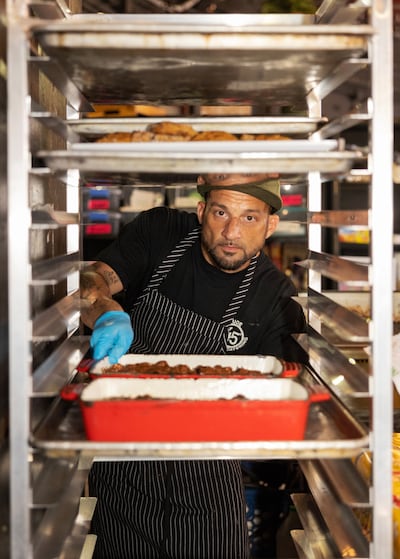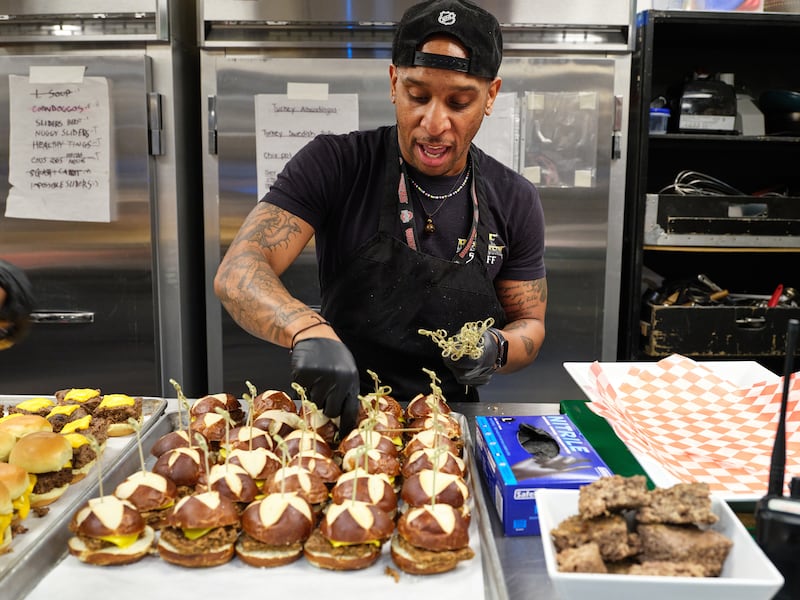
In Stockholm, it was the cookies – the black sesame, wasabi and white chocolate, or maybe the gluten-free coconut almond dark chocolate – that signalled to Beyoncé’s dancers, crew and roadies that Grant Bird was back.
Bird is an English pastry chef and one of 14 culinary professionals on Beyoncé’s current Renaissance World Tour, which has also employed a vegan chef and three personal chefs just for Queen B and her inner circle. After getting Covid during rehearsals in Paris, Bird had to take a weeklong break, leaving the dessert duties for the 400-600 crew members to two substitute chefs. By then, the crew had got used to his lavish desserts, which often featured a dozen different offerings at both lunch and dinner.
A pared-down sweets menu spoke to his absence. So when the crew once again saw his signature spread of hundreds of cookies in several varieties, they knew he had returned. “That was lunch, and the whole diningroom applauded,” says Bird, who has also cooked for Carrie Underwood, Justin Bieber and Mötley Crüe. “They just thought, ‘He’s got to be back. Because they just knew from the style.’”
Yes, Beyoncé is one of the world’s biggest stars, but travelling with a cadre of chefs isn’t just a flex. Many touring artists now take several professional cooks, not to mention entire mobile kitchens, on the road with them for efficiency, health and morale.
RM Block
While idiosyncrasies such as Van Halen’s ban on brown M&Ms have become familiar lore, the suspension of concerts during the Covid years has prompted an industrywide reset, with a focus on wellness. Many tours now include a vegan chef, for instance, and place a priority on physical and mental wellbeing as well as lessening environmental impact.
“Before, back in the early ’80s and ’90s, it was more of a party – cocaine and whatever they wanted. And now it’s just a business,” says Gray Rollin, Linkin Park’s long-time chef, who has also cooked on tours for Prince, Madonna and Tori Amos. “We have one job to do, and that job is to put that talent onstage. Make sure that the show goes flawlessly. And then do it again the next day.”
Joking about the 2014 tour by Linkin Park and Thirty Seconds to Mars, he adds: “It was called the Carnivores Tour, but 14 of the 16 guys we cooked for were vegan.”
James Digby, a veteran tour manager who had just finished working the European leg of Avril Lavigne’s tour, is familiar with such demands.
“You cannot get a nonvegetarian meal in catering on a Paul McCartney tour. That’s a challenge. Because most roadies I know are carnivores,” Digby says. “If the artist is trying to change the world, one tour at a time, by saying everybody’s a vegetarian, my job is to echo that.”

Regardless of the cuisine, the production demands are significant. The industry standard for a sizeable tour requires four meals on set-up and show days: breakfast, lunch, dinner and an after-concert meal, often eaten on a bus.
“An army marches on its stomach, so you’ve got to feed the troops,” Digby says. By troops, he means the band, the backup singers and dancers, stage builders, the pyrotechnics crew, security guards, managers, bus drivers and all the other people involved in the high-stakes business of live entertainment.
At a recent Lizzo show at Acrisure Arena in Palm Desert, California, lunch featured a juicing station with a blender-ready basket of vegetables. There were corn dogs, fried chicken sandwiches and plant-based Impossible sliders, as well as couscous, squash, carrots and cookies.
It was all prepared in the arena’s kitchen. Normally, however, Latitude 45, the company in charge of culinary operations for the vegan artist’s Special tour, cooks in an elaborate mobile kitchen that packs into specialised flight cases and is reassembled in each new city.
The custom-built kitchens, including cabinets, shelves, ovens and workstations, were constructed to maximise space and efficiency, and provide an elusive sense of “sameness” on the road, says Chris Mitchell, the company’s owner.
“Everything has a place, and it goes back to that same place every single day,” he explains. “If somebody in the kitchen needs a stainless steel bowl – and without looking most of the time – they can just point and say, ‘Would you please give me the third bowl in that stack over there?’”


HSG Catering, a Chicago-based company currently working on Eric Church’s tour, uses a 53-foot mobile kitchen containing a walk-in freezer, a walk-in cooler and an 80-gallon water heater. The unit is also equipped with a meat smoker, a wood-fired grill, convection ovens and a machine that can “sous vide 300 steaks at once,” says Bob Schneeberger, HSG’s president.
While chefs sometimes accompany artists on private jets or in armoured cars, with police escorts, cooking and baking on the road can also put them in generator-powered makeshift kitchens in fields or parking lots.
Mitchell says the job calls for a particular type of person who enjoys troubleshooting and being constantly on the move, and who can endure sleeping on tour buses for months at a time. The conditions cultivate a fraternity of sorts – many chefs proudly wear T-shirts from previous tours.
There’s also a royal-food-tester aspect to the gig.
“One case of food poisoning, and you’re cancelling shows for at least 48 hours,” Digby says. As shows become bigger spectacles and ticket prices soar ever higher, an incident like that can put millions of dollars at risk.
One thing that may not have changed much over time is the pickiness of the artists, who certainly have their idiosyncratic likes and dislikes.
“Gene Simmons used to like a turkey sandwich with lettuce, tomato and pickles on the side,” says Rollin, who cooked for the Kiss bassist in 2008 and 2009. “But then he would never touch the lettuce, pickles and tomatoes, ever.” Jared Leto would want organic purple popcorn with every meal.

Travel can also make the desired foods hard to come by. In the 1990s, Marilyn Manson insisted on Kraft Mac & Cheese, so boxes were shipped to England, Digby says. “Guess what? Kraft manufactures a different variety of Kraft macaroni and cheese for English consumers.”
Bird, who cooked for K-pop group Blackpink in Chicago last summer, said the band brought a separate truck just to transport its favoured brands of instant ramen noodles. Like some other caterers who have worked K-pop tours, Bird was impressed with the emphasis put on the culinary operations, which always included a Korean buffet. “They have so many different food stations and stuff. I’ve never seen that before,” he says.
As for Beyoncé, Bird sent fruit platters and cookies to her dressingroom. And while he can’t say for sure what the pop star’s favourites are, he notes: “As far as I’m aware, the ones that are particularly eaten are the Reese’s cups cookies” – a speciality of Bird’s that have a vanilla base with Belgian milk chocolate and bits of Reese’s Peanut Butter Cups folded throughout.
In addition to having his confections in high demand, Bird was touched to see his name in the online credits for the Renaissance tour.
[ Ireland’s Instagram foodies: Meet the new celebrity chefsOpens in new window ]
“At the end of the show, they normally give recognition to the lighting, the staging and people a lot closer to them,” says Bird, who is currently touring with country singer Sam Hunt. “But they never mention that they travel with us catering.” – This article originally appeared in the New York Times.



















